Prevention of Seabed Subsidence of Class-1 Gas Hydrate Deposits via CO2-EGR: A Numerical Study with Coupled Geomechanics-Hydrate Reaction-Multiphase Fluid Flow Model
Abstract
1. Introduction
2. Materials and Methods
2.1. Numerical Simulation
2.2. Gas Hydrate Reaction Module Design
2.3. Geomechanical Coupling Calculations
2.4. Study Process and Numerical Model Designs
2.4.1. Numerical Model Design
2.4.2. Geomechanics Module
2.4.3. Well Placement and Production Strategy
3. Results and Discussion
3.1. Production with Pure Depressurization
3.1.1. Effect of Production Pressure Drop
3.1.2. Effect of Production Gas Rate
3.2. CO2 Enhanced Gas Recovery
3.2.1. Delayed CO2 Injection Test
3.2.2. CO2 Injection with Different Pressures
3.2.3. The Limitation of the CO2 Fraction in the Produced Gas
4. Conclusions
Author Contributions
Funding
Acknowledgments
Conflicts of Interest
References
- Sun, C.C. Introduction of global gas hydrate resources. In Proceedings of the Cross-Strait Conference on Geochemical and Environmental Geology, Washington, DC, USA, 15 December 2016; pp. 118–119. [Google Scholar]
- Zhong, S.X. Review and Prospect of Methane Hydrate; Bulletin of the Central Geological Survey, MOEA: New Taipei, Taiwan, 2005. [Google Scholar]
- Sloan, E.D.; Koh, C.A. Clathrate Hydrates of Natural Gases; CRC Press: Boca Raton, FL, USA, 2007. [Google Scholar]
- Xia, Z. Production characteristic investigation of the Class I, Class II; and Class III hydrate reservoirs developed by the depressurization and thermal stimulation combined method. J. Pet. Sci. Eng. 2017, 157, 56–67. [Google Scholar] [CrossRef]
- Moridis, G.; Collett, T. Strategies for Gas Production from Hydrate Accumulations under Various Geologic Conditions; Lawrence Berkeley National Laboratory: Berkeley, CA, USA, 2003. [Google Scholar]
- Moridis, G.J. Challenges, Uncertainties and Issues Facing Gas Production from Gas Hydrate Deposits; Lawrence Berkeley National Lab.: Berkeley, CA, USA, 2010. [Google Scholar]
- Wu, C.-Y.; Hsieh, B.-Z. Depressurization on Gas Production from Gas Hydrate Prospect on Yuan—An Ridge Offshore Southwest Taiwan. Mining & Metallurgy: The Bulletin of the Chinese Institute of Mining & Metallurgical Engineers; Elsevier: Amsterdam, The Netherlands, 2016; Volume 60, pp. 46–61. [Google Scholar]
- Merey, Ş.; Longinos, S.N. Numerical simulations of gas production from Class 1 hydrate and Class 3 hydrate in the Nile Delta of the Mediterranean Sea. J. Nat. Gas Sci. Eng. 2018, 52, 248–266. [Google Scholar] [CrossRef]
- Oragui, O. Methane Production from Gas-Hydrate Using Depressurization Method. Master’s Thesis, Civil Engineering and Geosciences, Stevinweg, The Netherlands, 2010. [Google Scholar]
- Diaconescu, C.C.; Knapp, J. Gas Hydrates of the South Caspian Sea, Azerbaijan: Drilling hazards and sea floor destabilizers. In Proceedings of the Offshore Technology Conference, Richardson, TX, USA, 6–9 May 2002. [Google Scholar] [CrossRef]
- Ruppel, C.D. Gas Hydrate in Nature; U.S. Geological Survey: Reston, VA, USA, 2018; pp. 2017–3080.
- Wu, C.-Y.; Chiu, Y.-C.; Huang, Y.-J.; Hsieh, B.-Z. Effects of Geomechanical Mechanisms on Gas Production Behavior: A Simulation Study of a Class-3 Hydrate Deposit of Four–Way–Closure Ridge Offshore Southwestern Taiwan. Energy Procedia; Elsevier: Amsterdam, The Netherlands, 2017; Volume 125, pp. 486–493. [Google Scholar]
- Yang, Y.; He, Y.; Zheng, Q. An analysis of the key safety technologies for natural gas hydrate exploitation. Adv. Geo-Energy Res. 2017, 1, 100–104. [Google Scholar] [CrossRef]
- Rutqvist, J.; Moridis, G.J. Numerical studies on the geomechanical stability of hydrate-bearing sediments. In Proceedings of the Offshore Technology Conference, Houston, TX, USA, 30 April–3 May 2007. [Google Scholar] [CrossRef]
- Gupta, S.; Helmig, R.; Wohlmuth, B. Non-isothermal, multi-phase, multi-component flows through deformable methane hydrate reservoirs. Comput. Geosci. 2015, 19, 1063–1088. [Google Scholar] [CrossRef]
- Wang, Y.; Feng, J.-C.; Li, X.-S.; Zhang, Y.; Han, H. Methane Hydrate Decomposition and Sediment Deformation in Unconfined Sediment with Different Types of Concentrated Hydrate Accumulations by Innovative Experimental system. Applied Energy; Elsevier: Amsterdam, The Netherlands, 2018; Volume 226, pp. 916–923. [Google Scholar]
- Ruppel, C.D.; Kessler, J.D. The Interaction of Climate Change and Methane Hydrates. Reviews of Geophysics; The American Geophysical Union: Washington, DC, USA, 2017; Volume 55, pp. 126–168. [Google Scholar]
- Dhakal, S.; Gupta, I. Predictive modeling of thermogenic methane hydrate formation and geobody distribution–results from numerical simulations. J. Nat. Gas Sci. Eng. 2020, 75, 103154. [Google Scholar] [CrossRef]
- Kim, T.H.; Cho, J.; Lee, K.S. Evaluation of CO2 Injection in Shale Gas Reservoirs with Multi–Component Transport and Geomechanical Effects. Applied Energy; Elsevier: Amsterdam, The Netherlands, 2017; Volume 190, pp. 1195–1206. [Google Scholar]
- Narinesingh, J.; Alexander, D. CO2 Enhanced Gas Recovery and Geologic Sequestration in Condensate Reservoir: A Simulation Study of the Effects of Injection Pressure on Condensate Recovery from Reservoir and CO2 Storage Efficiency. Energy Procedia; Elsevier: Amsterdam, The Netherlands, 2014; Volume 63, pp. 3107–3115. [Google Scholar]
- Al-Hasami, A.; Ren, S.; Tohidi, B. CO2 injection for enhanced gas recovery and geo–storage: Reservoir simulation and economics. In Proceedings of the SPE Europec/EAGE Annual Conference. Society of Petroleum Engineers, Madrid, Spain, 13–16 June 2005. [Google Scholar] [CrossRef]
- Clemens, T.; Secklehner, S.; Mantatzis, K.; Jacobs, B. Enhanced Gas Recovery-Challenges shown at the example of three gas fields. In Proceedings of the SPE EUROPEC/EAGE Annual Conference and Exhibition. Society of Petroleum Engineers, Barcelona, Spain, 14–17 June 2010; p. 17. [Google Scholar]
- Solano, S.V.; Nicot, J.-P.; Hosseini, S.A. Sensitivity Study of CO2 Storage in Saline Aquifers in the Presence of a Gas Cap. Energy Procedia; Elsevier: Amsterdam, The Netherlands, 2011; Volume 4, pp. 4508–4515. [Google Scholar]
- Kalra, S.; Wu, X. CO2 Injection for Enhanced Gas Recovery, SPE Western North American and Rocky Mountain Joint Meeting; Society of Petroleum Engineers: Denver, CO, USA, 2014; p. 15. [Google Scholar]
- Gou, Y.; Hou, Z.; Li, M.; Feng, W.; Liu, H. Coupled thermo–hydro–mechanical simulation of CO2 enhanced gas recovery with an extended equation of state module for TOUGH2MP-FLAC3D. J. Rock Mech. Geotech. Eng. 2016, 8, 904–920. [Google Scholar] [CrossRef]
- Anwar, M. CO2 capture and storage: A way forward for sustainable environment. J. Environ. Manag. 2018, 226, 131–144. [Google Scholar] [CrossRef] [PubMed]
- CMG. STARS USER GUIDE; Computer Modelling Group Ltd.: Calgary, AB, Canada, 2015. [Google Scholar]
- Wu, C.-Y. Comparisons of Different Hydrate Simulation Design for Class–1 Gas Hydrate Deposits. Ph.D. Thesis, Degree in National Cheng Kung University Department of Resources Engineering, Taipei City, Taiwan, 2018; pp. 1–114. [Google Scholar]
- CMG. Gas Hydrate Simulation Using STARS; Computer Modelling Group Ltd.: Calgary, AB, Canada, 2009. [Google Scholar]
- Gaddipati, M. Code Comparison of Methane Hydrate Reservoir Simulators Using CMG STARS; West Virginia University: Morgantown, WV, USA, 2008. [Google Scholar]
- Uddin, M.; Coombe, D.; Law, D.; Gunter, B. Numerical studies of gas hydrate formation and decomposition in a geological reservoir. J. Energy Resour. Technol. 2008, 130, 032501. [Google Scholar] [CrossRef]
- Zhou, X.; Fan, S.; Liang, D.; Du, J. Determination of Appropriate Condition on Replacing Methane from Hydrate with Carbon Dioxide. Energy Conversion and Management; Elsevier: Amsterdam, The Netherlands, 2008; Volume 49, pp. 2124–2129. [Google Scholar]
- CMG. Geomechanics Using GEM and STARS; Computer Modelling Group Ltd.: Calgary, AB, Canada, 2015. [Google Scholar]
- Tran, D.; Shrivastava, V.K.; Nghiem, L.X.; Kohse, B.F. Geomechanical risk mitigation for CO2 sequestration in saline aquifers. In Proceedings of the SPE Annual Technical Conference and Exhibition, Society of Petroleum Engineers, New Orleans, LA, USA, 4–7 October 2009. [Google Scholar] [CrossRef]
- Pinkert, S.; Grozic, J. Prediction of the mechanical response of hydrate-bearing sands. J. Geophy. Res. Solid Earth 2014, 119, 4695–4707. [Google Scholar] [CrossRef]
- Song, B. Seafloor subsidence response and submarine slope stability evaluation in response to hydrate dissociation. J. Nat. Gas Sci. Eng. 2019, 65, 197–211. [Google Scholar] [CrossRef]
- Sun, X.; Wang, L.; Luo, H.; Song, Y.; Li, Y. Numerical modeling for the mechanical behavior of marine gas hydrate-bearing sediments during hydrate production by depressurization. J. Pet. Sci. Eng. 2019, 117, 971–982. [Google Scholar] [CrossRef]
- Gaddipati, M. Reservoirs Modeling of Gas Hydrate Deposits in North Slope of Alaska and Gulf of Mexico; West Virginia University: Morgantown, WV, USA, 2014. [Google Scholar]
- Leeuwenburgh, O. Enhanced Gas Recovery—A Potential ‘U’for CCUS in The Netherlands. Energy Procedia; Elsevier: Amsterdam, The Netherlands, 2014; Volume 63, pp. 7809–7820. [Google Scholar]


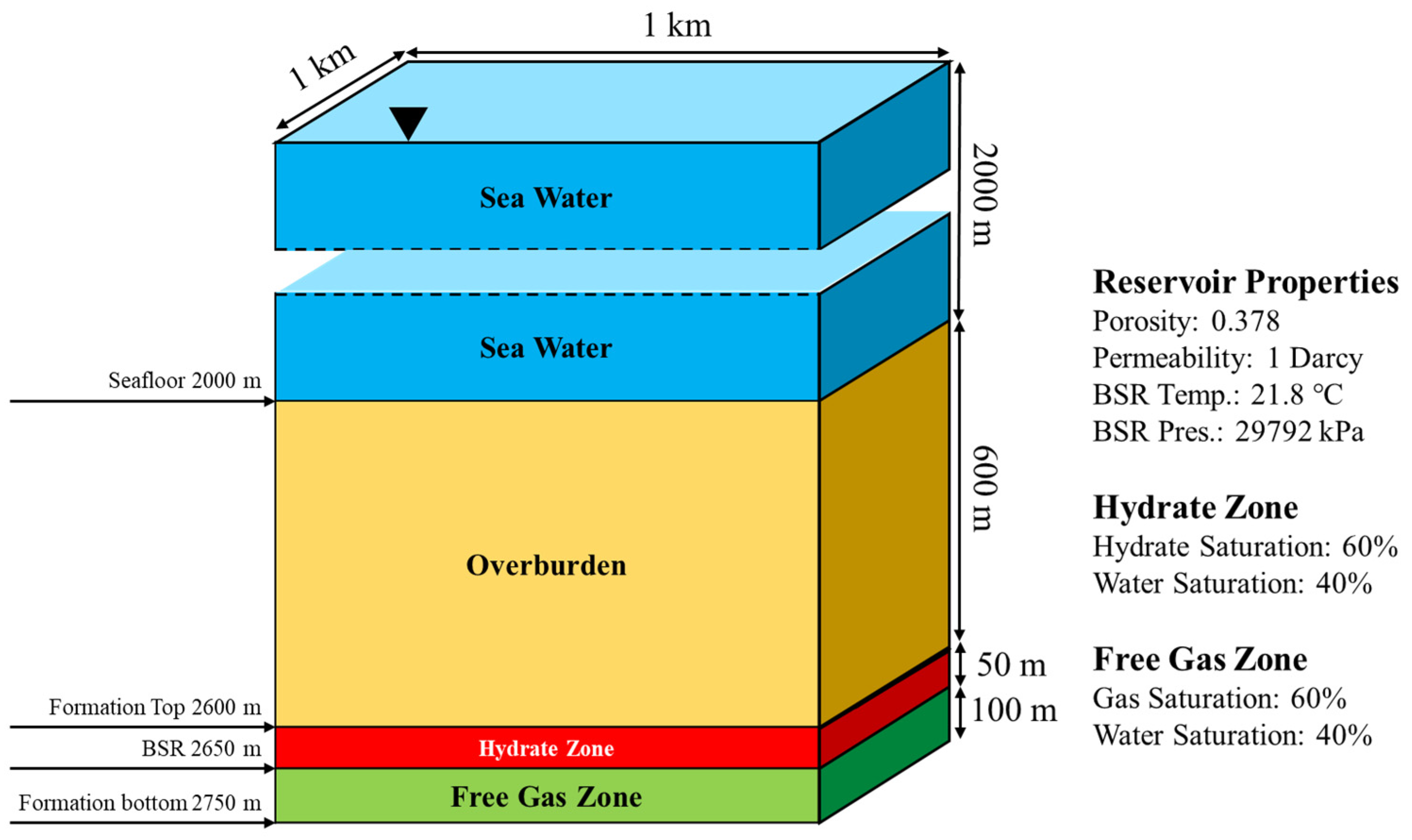
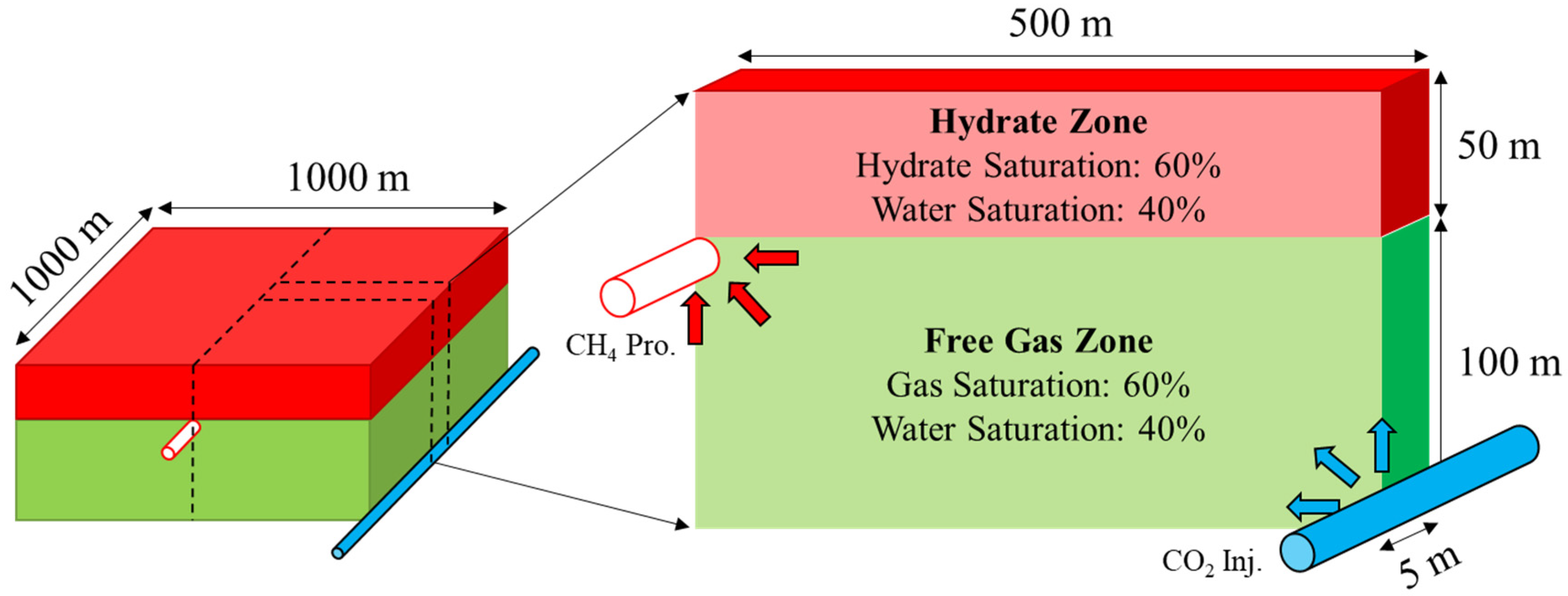
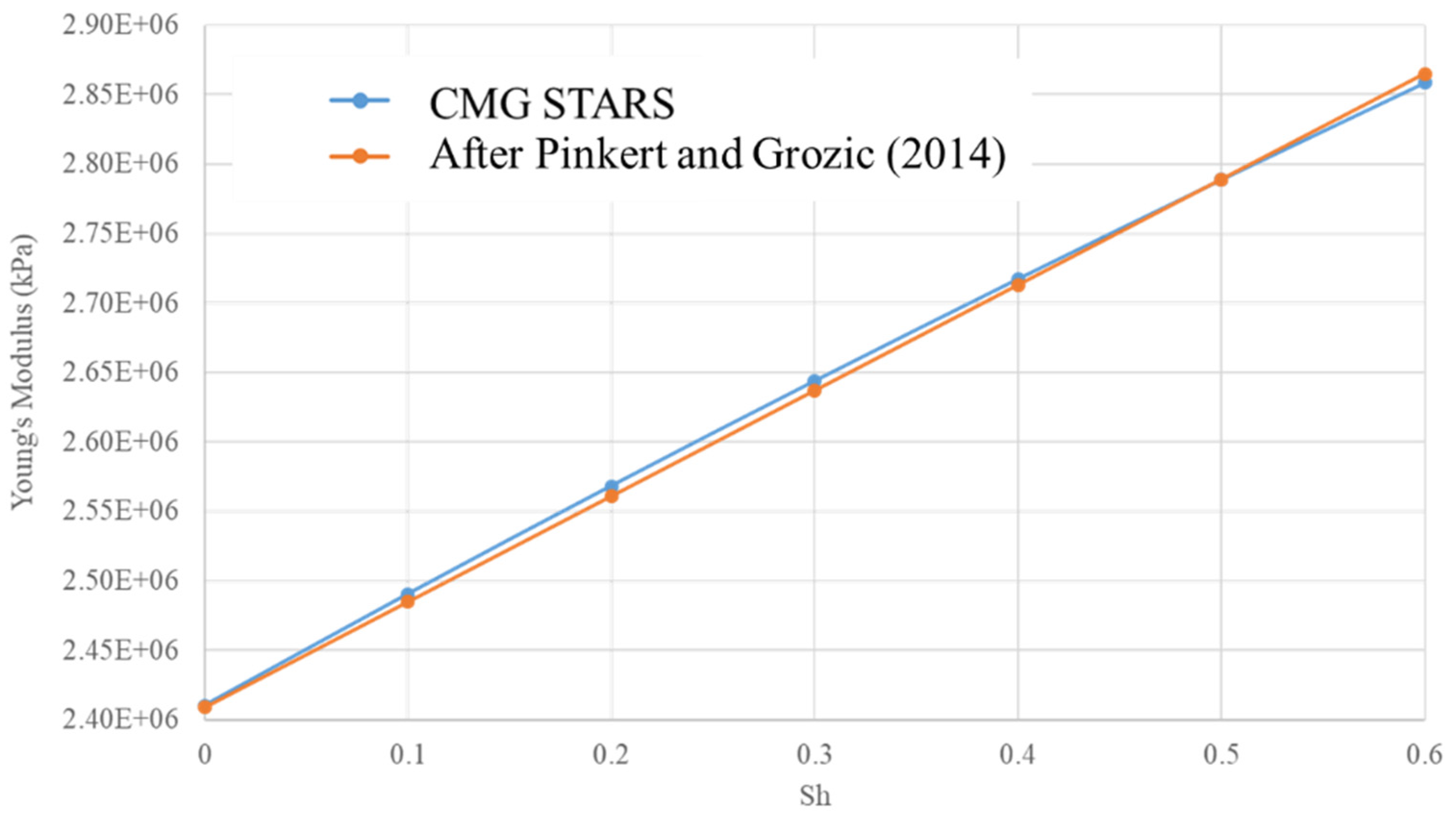
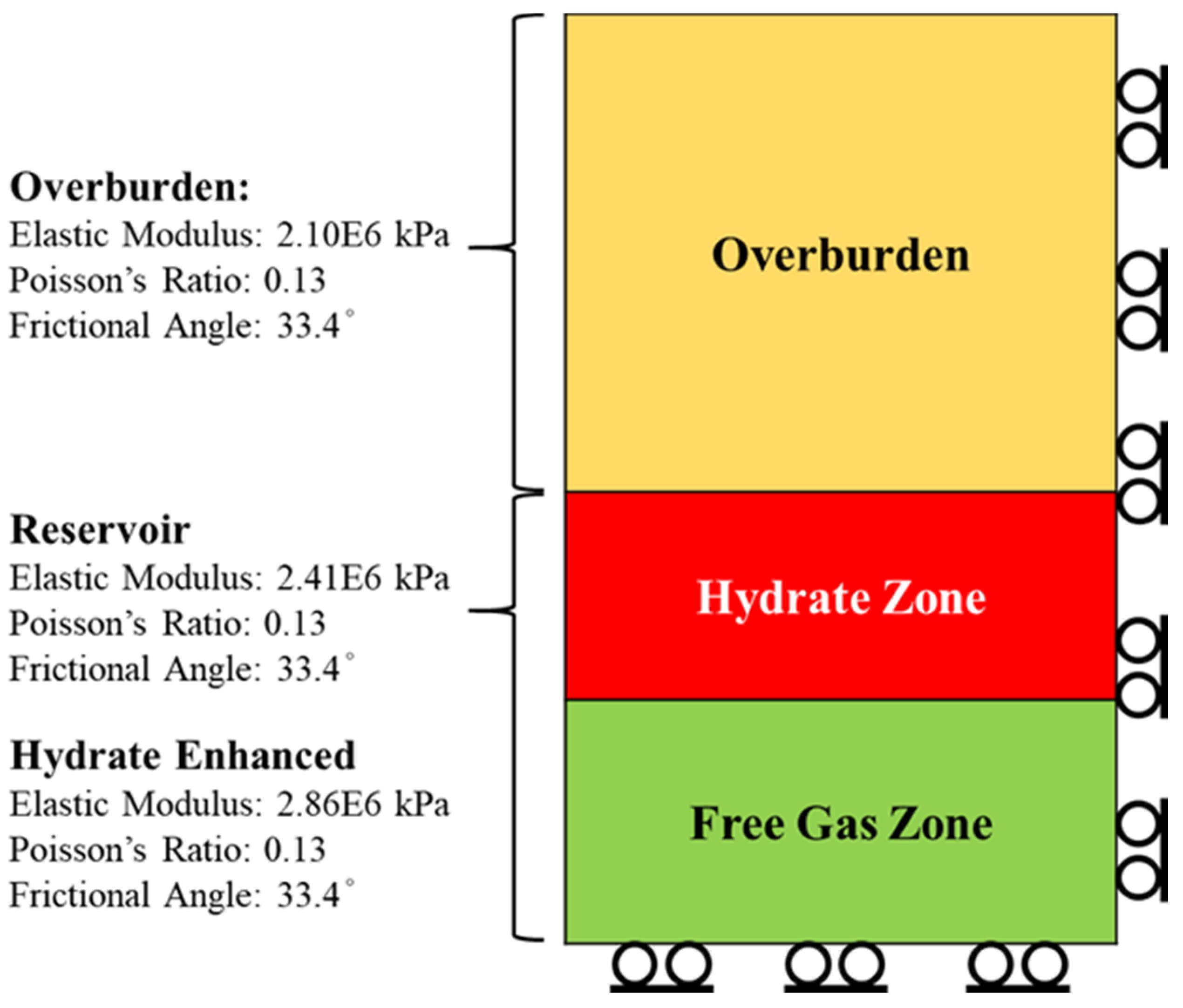


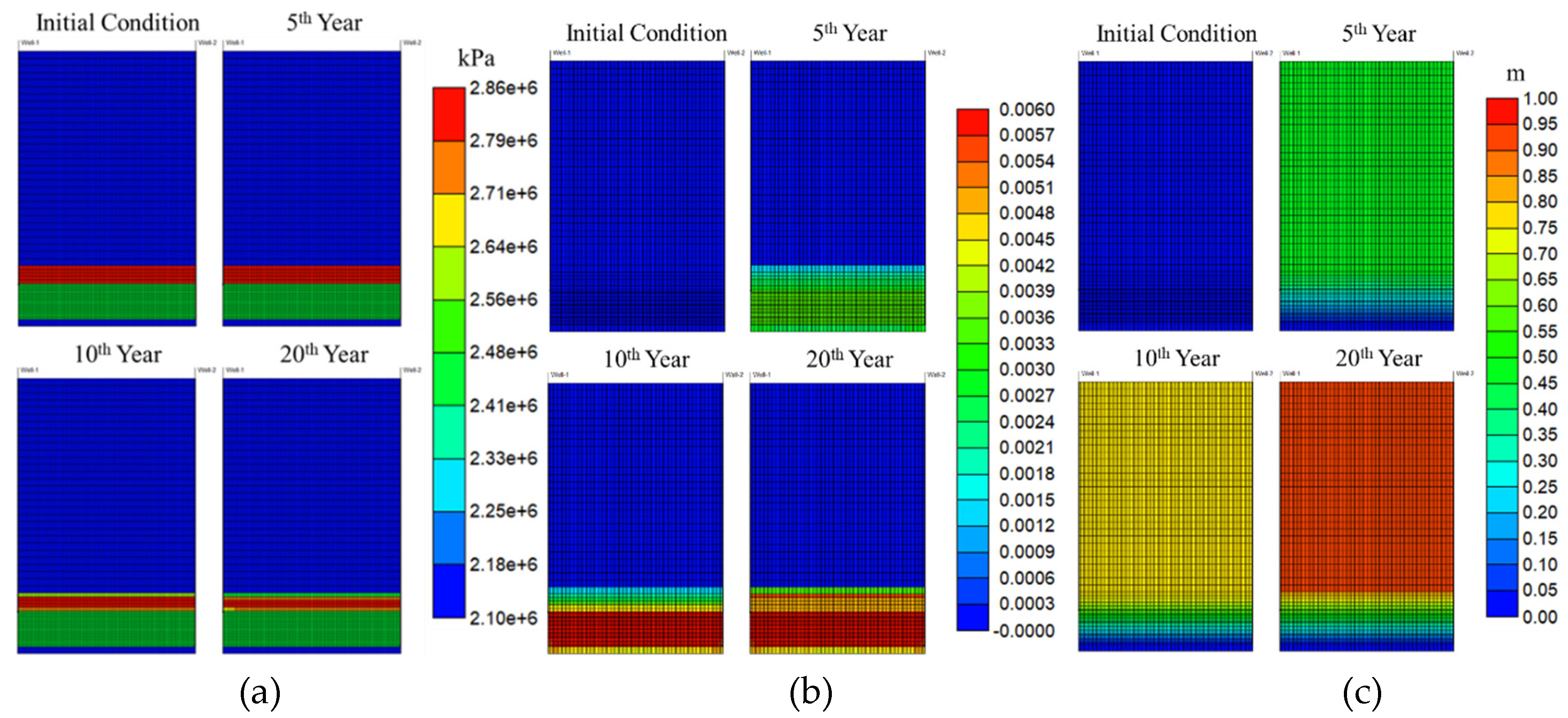
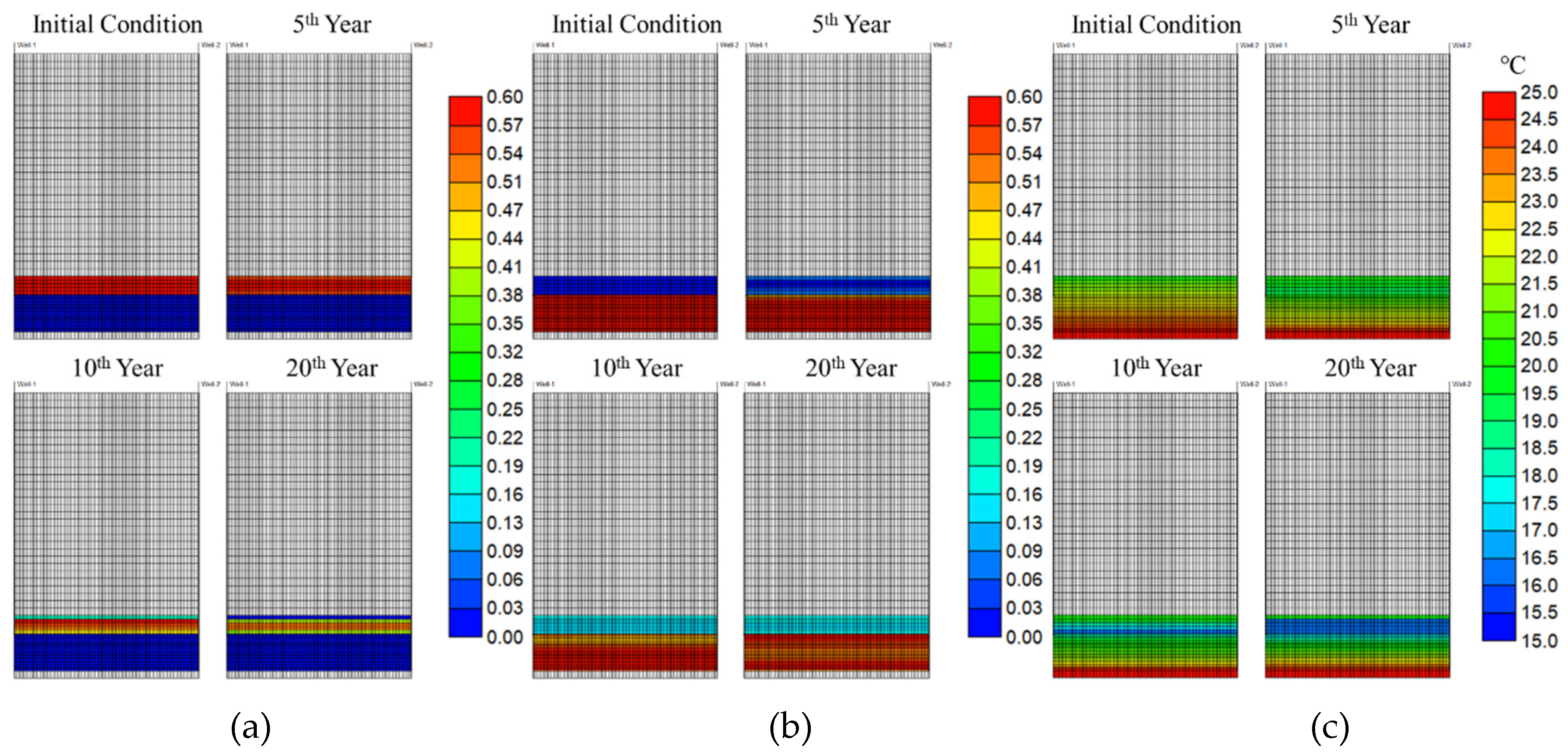
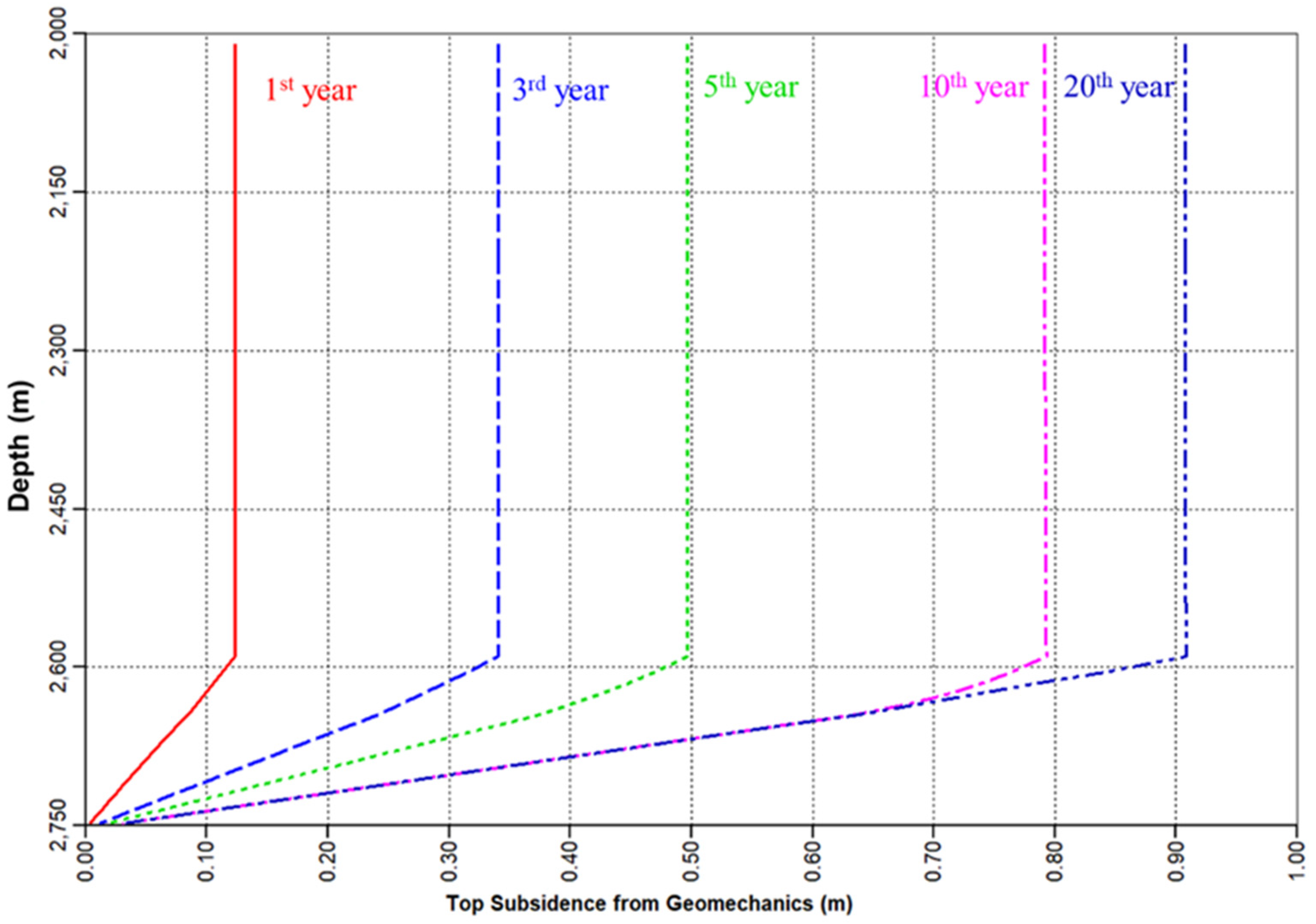


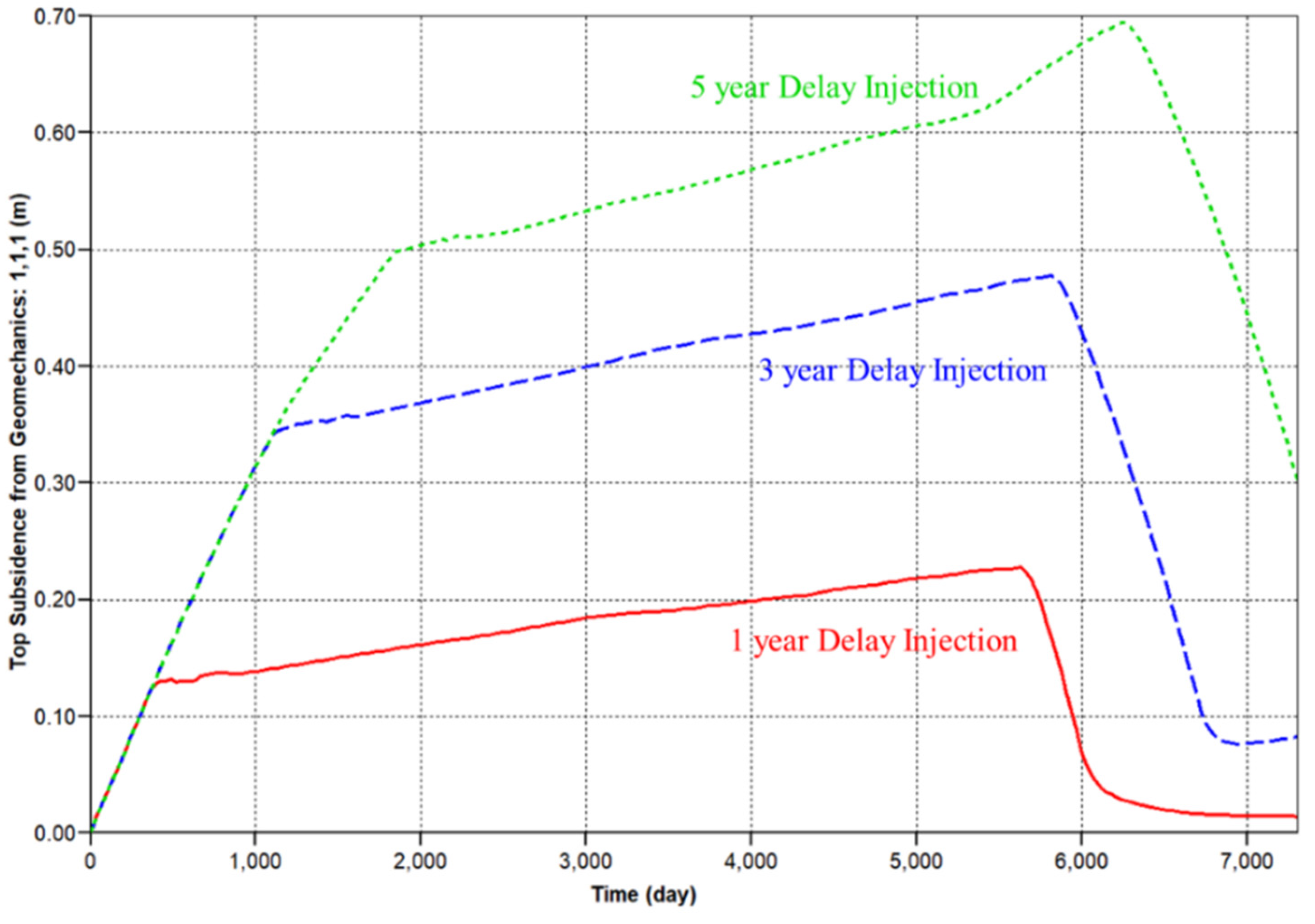
| Correlation Coefficients of the Equilibrium Constant for Methane Hydrates | |||||
|---|---|---|---|---|---|
| Coefficient | rxk1 | rxk2 | rxk3 | rxk4 | rxk5 |
| Value | 2.66 × 1010 | −3.5 | 7.5 × 105 | −2506 | −154 |
| Parameters | Hydrate Zone | Free Gas Zone |
|---|---|---|
| Porosity | 0.378 | 0.378 |
| Permeability | 1000 mD | 1000 mD |
| Hydrate saturation | 60% | 0% |
| Water saturation | 40% | 40% |
| Gas saturation | 0% | 60% |
| Parameter | Value | Unit |
|---|---|---|
| e1 | 2,412,000 | kPa |
| e2 | 0.678 | - |
| e3 | 760,000 | kPa |
| σ'3 | 29,792 | kPa |
| ER | 2,410,000 | kPa |
| EH | 4,032,920 | kPa |
| m | 2 | - |
| Parameter | Value | Unit |
|---|---|---|
| Grid design | 101 × 1 × 25 | - |
| Reservoir volume | 500 × 5 × 150 | m |
| Seafloor depth | 2000 | m |
| Formation top depth | 2600 | m |
| Bottom simulating reflector depth | 2650 | m |
| Porosity | 0.378 | Frac. |
| Horizontal absolute permeability | 1000 | mD |
| Vertical absolute permeability | 100 | mD |
| Thermal conductivity of the reservoir rock | 1.73 × 105 | J/(m·day·C) |
| Thermal conductivity of the water phase | 2.25 × 105 | J/(m·day·C) |
| Thermal conductivity of the gas phase | 5.18 × 104 | J/(m·day·C) |
| Thermal conductivity of the hydrate | 3.40 × 104 | J/(m·day·C) |
| Parameter | Min. Bottom Hole Pressure | Max. Production Rate | Cumulative Gas | Hydrate Dissociation Ratio | RF in Free Gas Zone | RF Overall | Seafloor Subsidence |
|---|---|---|---|---|---|---|---|
| unit | kPa | scm/day | MMscm | % | % | % | m |
| Case of pressure drop 30% | 21,000 | 2500 | 5.36 | 26.00% | 29.04% | 22.44% | 0.522 |
| Case of pressure drop 50% | 15,000 | 2500 | 9.99 | 38.90% | 54.14% | 41.82% | 0.907 |
| Case of pressure drop 70% | 9000 | 2500 | 15.32 | 55.20% | 83.04% | 64.15% | 1.281 |
| Parameter | Min. Bottom Hole Pressure | Max. Production Rate | Cumulative Gas | Hydrate Dissociation Ratio | RF in Free Gas Zone | RF Overall | Seafloor Subsidence |
|---|---|---|---|---|---|---|---|
| unit | kPa | scm/day | MMscm | % | % | % | m |
| Case of 2000 scm/day | 15,000 | 2000 | 9.91 | 37.44% | 53.72% | 41.50% | 0.907 |
| Case of 2500 scm/day | 15,000 | 2500 | 9.99 | 38.90% | 54.14% | 41.82% | 0.907 |
| Case of 3000 scm/day | 15,000 | 3000 | 9.96 | 39.37% | 54.01% | 41.72% | 0.907 |
| Parameter | Min. Bottom Hole Pressure | Max. Production Rate | CO2 Inj. Rate | Production Duration | Cumulative Gas Production | Cumulative CO2 Injection | Hydrate Dissociation Ratio | RF in Free Gas Zone | RF Overall | Seafloor Subsidence |
|---|---|---|---|---|---|---|---|---|---|---|
| unit | kPa | scm/day | scm/day | Days | MMscm | MMscm | % | % | % | m |
| Case of pure depressurization | 21,000 | 2500 | - | 7305 | 5.36 | - | 26.00% | 29.04% | 22.44% | 0.522 |
| Case of CO2-EGR | 21,000 | 2500 | 3900 | 5630 | 13.84 | 21.82 | −0.41% | 75.04% | 57.97% | 0.036 |
| Parameter | Min. Bottom Hole Pressure | Max. Production Rate | CO2 Inj. Rate | Production Duration | Cumulative Gas Production | Cumulative CO2 Injection | RF in Free Gas Zone | RF Overall | Max. Seafloor Subsidence | Final Seafloor Subsidence |
|---|---|---|---|---|---|---|---|---|---|---|
| unit | kPa | scm/day | scm/day | Days | MMscm | MMscm | % | % | m | m |
| Case of no injection delay | 15,000 | 2500 | 3900 | 5630 | 13.84 | 21.82 | 75.04% | 57.97% | 0.036 | 0.036 |
| Case of 1-year injection delay | 15,000 | 2500 | 3900 | 5660 | 13.87 | 21.96 | 75.22% | 58.10% | 0.228 | 0.014 |
| Case of 3-year injection delay | 15,000 | 2500 | 3900 | 5844 | 14.34 | 21.96 | 77.72% | 60.04% | 0.478 | 0.082 |
| Case of 5-year injection delay | 15,000 | 2500 | 3900 | 6241 | 15.40 | 21.36 | 83.50% | 64.50% | 0.694 | 0.303 |
| Parameter | Min. Bottom Hole Pressure | Max. Production Rate | CO2 Inj. Pressure | Production Duration | Cumulative CH4 Production | Cumulative CO2 Injection | Hydrate Dissociation Ratio | RF in Free Gas Zone | RF Overall | Seafloor Subsidence |
|---|---|---|---|---|---|---|---|---|---|---|
| unit | kPa | scm/day | kPa | Days | MMscm | MMscm | % | % | % | m |
| Case of 60% injection pressure | 15,000 | 2500 | 18,000 | 6210 | 15.39 | 16.06 | 34.08% | 83.43% | 64.45% | 0.754 |
| Case of 80% injection pressure | 15,000 | 2500 | 24,000 | 5844 | 14.41 | 19.64 | 14.89% | 78.13% | 60.36% | 0.359 |
| Case of 100% injection pressure | 15,000 | 2500 | 30,000 | 5630 | 13.84 | 21.82 | −0.41% | 75.04% | 57.97% | 0.036 |
| Parameter | Min. Bottom Hole Pressure | Max. Production Rate | Production Duration | Cumulative Gas Production | Cumulative CO2 Injection | RF in Free Gas Zone | RF Overall | Seafloor Subsidence |
|---|---|---|---|---|---|---|---|---|
| unit | kPa | scm/day | Day | MMscm | MMscm | % | % | m |
| Case of 10% limitation of CO2 | 15,000 | 2500 | 5630 | 13.84 | 21.82 | 75.04% | 57.97% | 0.036 |
| Case of 20% limitation of CO2 | 15,000 | 2500 | 6179 | 15.01 | 23.84 | 81.35% | 62.84% | 0.037 |
| Case of 30% limitation of CO2 | 15,000 | 2500 | 6575 | 15.76 | 25.23 | 85.43% | 65.99% | 0.038 |
© 2020 by the authors. Licensee MDPI, Basel, Switzerland. This article is an open access article distributed under the terms and conditions of the Creative Commons Attribution (CC BY) license (http://creativecommons.org/licenses/by/4.0/).
Share and Cite
Lin, T.-K.; Hsieh, B.-Z. Prevention of Seabed Subsidence of Class-1 Gas Hydrate Deposits via CO2-EGR: A Numerical Study with Coupled Geomechanics-Hydrate Reaction-Multiphase Fluid Flow Model. Energies 2020, 13, 1579. https://doi.org/10.3390/en13071579
Lin T-K, Hsieh B-Z. Prevention of Seabed Subsidence of Class-1 Gas Hydrate Deposits via CO2-EGR: A Numerical Study with Coupled Geomechanics-Hydrate Reaction-Multiphase Fluid Flow Model. Energies. 2020; 13(7):1579. https://doi.org/10.3390/en13071579
Chicago/Turabian StyleLin, Tzu-Keng, and Bieng-Zih Hsieh. 2020. "Prevention of Seabed Subsidence of Class-1 Gas Hydrate Deposits via CO2-EGR: A Numerical Study with Coupled Geomechanics-Hydrate Reaction-Multiphase Fluid Flow Model" Energies 13, no. 7: 1579. https://doi.org/10.3390/en13071579
APA StyleLin, T.-K., & Hsieh, B.-Z. (2020). Prevention of Seabed Subsidence of Class-1 Gas Hydrate Deposits via CO2-EGR: A Numerical Study with Coupled Geomechanics-Hydrate Reaction-Multiphase Fluid Flow Model. Energies, 13(7), 1579. https://doi.org/10.3390/en13071579





